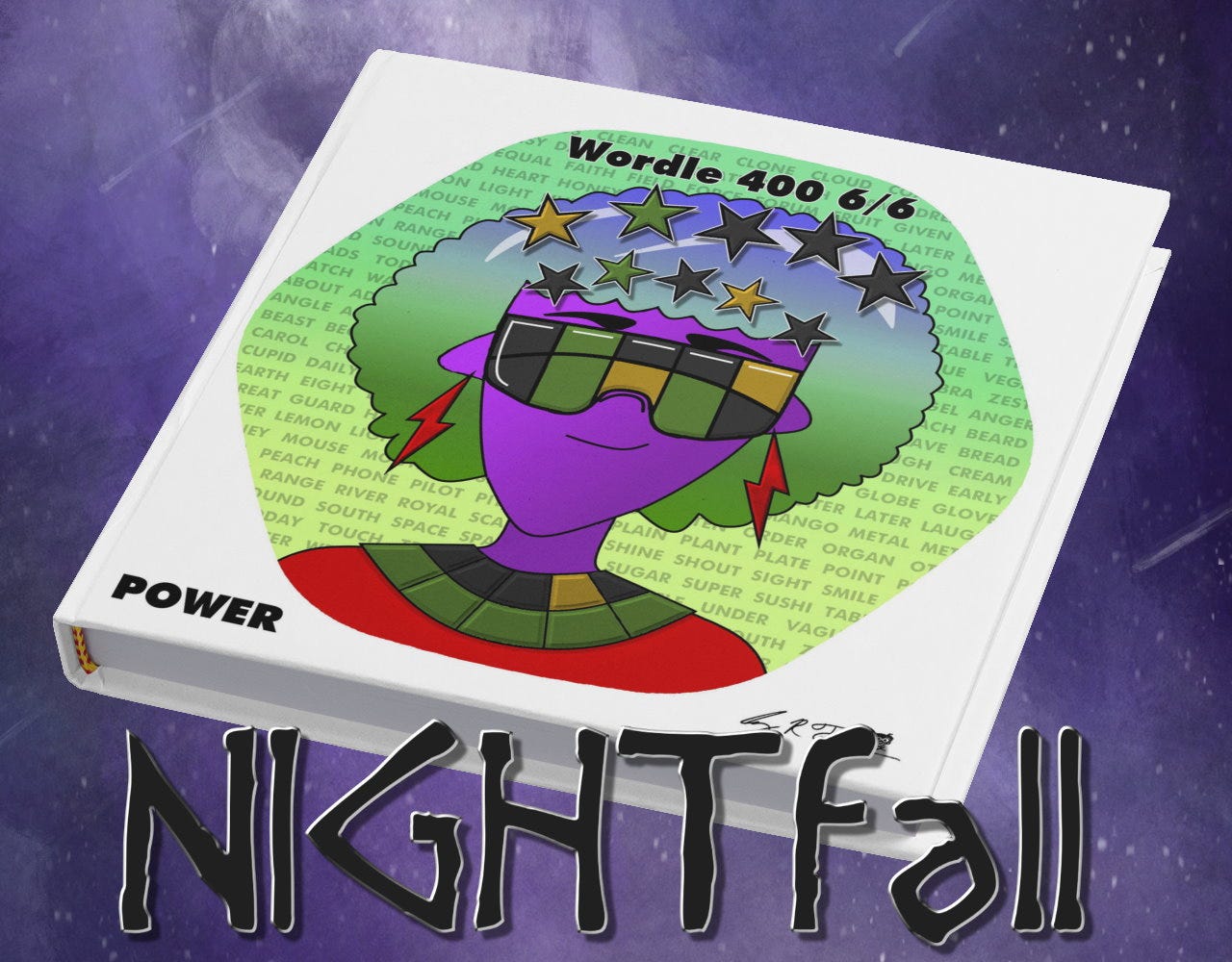It’s Day 400 in Wordler Village!
Big announcements in play for the Wordler world and our own...
I hope you’ve been enjoying the daily releases of episodes from my current Wordlers storyline, NIGHTfall over on Greg.Cent.co. As of today, eight episodes have been released, all free to read, with the most recent at any given time being available as a free-to-mint token. For today’s Day 400 episode, some milestone in-story events will change the story forever.
Things in our own world are also changing. Readers who check in regularly have been able to grow their collections of story tokens. But soon, the holders of these tokens will gain co-author rights in the story itself!
More on that below.
The unedited and admittedly rough drafts of NIGHTfall that you’ve been reading are part of my ongoing experiments in Web3 publishing, an industry that revels in rough edges and experimentation. The Web3 publishing sector is still in the early stages of building an infrastructure, creating new standards, and forming its cultures and communities, but make no mistake. NFT books are on their way, and a few early examples are already showing enormous potential.
The Wordlers project isn’t the first, or the best known, or the most profitable Web3 literary project. But thanks to you, Wordlers does currently hold the distinction of minting more tokens to more blockchains than any other Web3 literary project to date. As of this week, over twenty thousand story tokens are in circulation, plus about five thousand COUNTdown tokens and thousands of essay tokens.
Also this week, Published NFT announced that the first WORDLERplex short story, NIGHTvision, will be minted to a sixth blockchain, Flow, the on-chain home to the NBA, NFL, and Ticketmaster. Welcome to the big leagues.
Things are moving fast in the Web3 space. Even as the NIGHTfall storyline unfolds and the Wordler project stretches its reach, further iterations in blockchain technology are providing new boundaries to push against.
One boundary is sustainability, particularly when it comes to the carbon footprint of literary tokens. The vast majority of Wordlers tokens have been minted to the energy-efficient Polygon blockchain, rendered carbon-neutral through offsets at the blockchain level, and made carbon-positive by additional offsets purchased by Cryptoversal Books. The initial goal was to remove two CO2 molecules from the atmosphere for every one we’re responsible for, but the longer-term goal is to not put out as much CO2 in the first place. A big step toward that goal will happen in the next week or so.
The Ethereum blockchain is completing a long-planned transition to a much cleaner protocol. And since most of Polygon’s existing carbon footprint comes from checking batched transactions into the Ethereum blockchain, a cleaner Ethereum means that Polygon-based tokens will also become many times cleaner. By the end of the NIGHTfall storyline, we should be able to mint thousands of story tokens in the same carbon footprint as a single token from the start of the storyline.
Another boundary is on the legal frontier. The digital ownership enabled by NFTs is a legal terra nova when it comes to property rights, and intellectual property rights in particular. Some of the most successful projects in the Web3 space are valued for the rights they purport to convey upon the holders of their tokens, and the potential for those rights to be commercialized. At least in theory. It just may take a few years for those theoretical rights to be fully defined through litigation and precedent.
In the past week or so, Andreessen Horowitz released a set of high-quality NFT licenses that go a long way toward standardizing terms and filling the gaps in existing license models. These “Can’t Be Evil” licenses allow modifications and adaptations. They support sublicensing for current holders and transparency for potential buyers. They mitigate infringing or misappropriated content. They terminate rights in stolen or illegally acquired NFTs. They can’t be revoked by bad-faith creators but, in some variants, can be revoked by creators to prevent bad-faith holders from using tokens to promote hate speech.
Tailored for visual NFTs, the “Can’t Be Evil” licenses don’t meet all of the specific needs of the literary community, at least not out of the box, but they can provide a base for a clever IP lawyer to work with. And they have. And Wordlers will soon become the first literary-based project to apply a CBE-based licensing scheme called the NFT-Mediated Co-Author License.
Details will be shared shortly, but while you are collecting story episodes, you will also be collecting co-author rights to story elements within the Wordlers universe. The more episodes you claim, the more story elements you’ll be able to use in your own stories. A bit like fan-fiction, but with an on-chain license allowing you to publish and sell the derivative works you make.
When the NCL drops, this project will become a community of over 3,000 co-authors. I look forward to seeing what you create.
As always, leave comments and questions below and feel free to pass this newsletter on to anyone who might be interested in our project.
—Wordler in Chief, Greg R. Fishbone







Some interesting stuff here. I've seen the Wordlers thing, but I haven't done it. I'll look into it more, thanks to you.
So what exactly is required to submit a story? A part of the story collected and a submission on the day the WORD is given? Or is an invite to submit required first? Are there multiple submissions for each day?
Thanks!
-Inslterested Warlock